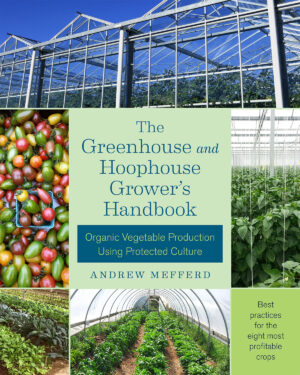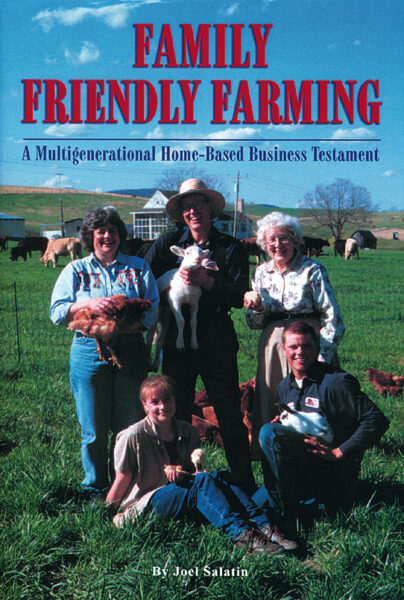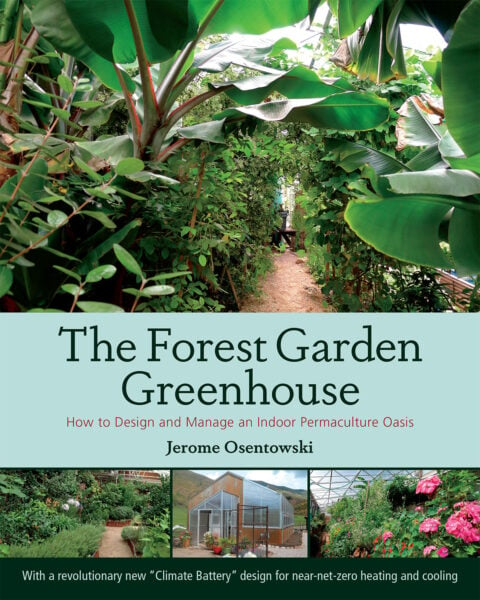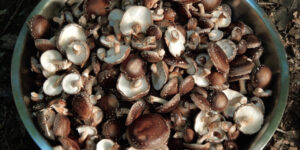Choosing the Best Heat Source for Your Greenhouse
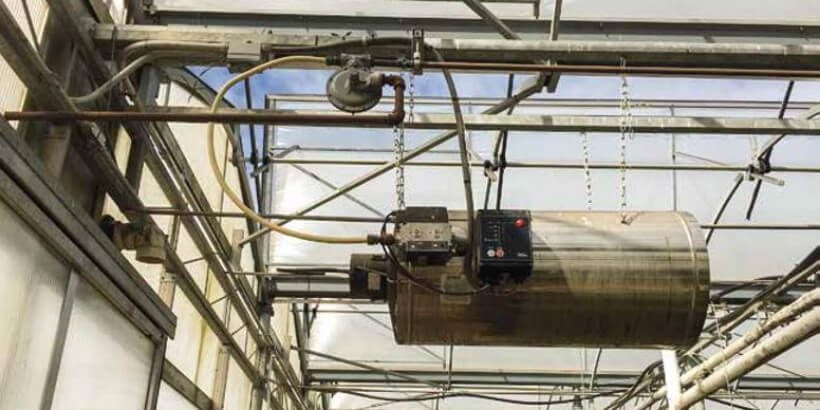
When it comes to heating your greenhouse, the options may seem endless and expensive. Fear not! Growing your own food in the cold weather doesn’t have to break the bank.
The best solution differs from farm to farm; it depends on the climate, crops grown, and the greenhouse structure itself. Harness the advancements in greenhouse technology to maximize your greenhouse yield and your bottom line.
The following is an excerpt from The Greenhouse and Hoophouse Grower’s Handbook by Andrew Mefferd. It has been adapted for the web.
The best source of heat depends a great deal on what’s available in your area. For many greenhouse growers, the cost of heating a greenhouse is second only to the cost of labor.
Choose your fuel source carefully, because it will have a big impact on your bottom line.
A lot of greenhouses went out of business in the 1970s during the energy crisis, when spiking energy costs blew many budgets.
Though heating has gotten more efficient since then, technology alone may not be enough to keep growers in business through fuel price fluctuations.
As renewable heating options improve, these sources will become a more important piece of the greenhouse heat puzzle, because they displace some of the need for fossil fuels.
The simplest thermostat I ever heard of belonged to a grower who told me he would sleep out in his tomato house in the springtime when the nights were still freezing. If he woke up and his nose was cold, he would turn on the heater.
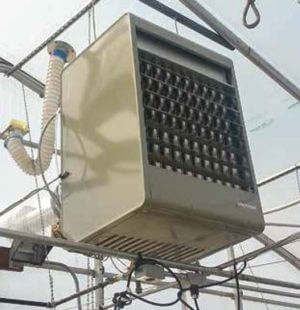
A unit heater
It may be romantic to sleep out with your tomatoes and take care of them when they need it, but having a heat source that is self-feeding (and thermostatically controlled) is more than just a convenience.
Self-controlled heating will even out the highs and lows in temperature caused by a direct heat source, such as a woodstove, as it heats up and cools down.
Plants appreciate consistency and will grow better with heat that stays evenly at the right temperature.
Most of the commercially available options for heating greenhouses use self-feeding fuel and self- starting heaters.
There are some heat sources that are not self-feeding, like most biomass or wood boilers, which can deliver more consistent temperatures by heating water, which is used to heat the air.
Organic Matter
Cordwood, wood pellets, and biomass can all be used to heat a greenhouse.
Biomass can include many types of organic matter; heaters have been designed to handle a wide range of inputs, including agricultural residues, wood by-products, and even grain.
Wood and biomass may be competitively priced compared with other fuels, and some growers appreciate sourcing their fuel locally.
If there is industry in your area that generates organic matter as a by-product, find out if it can be obtained cheaply to fuel a biomass heater.
On the other hand, the size and volume of cordwood and biomass may complicate delivery and feeding. Wood pellets and biomass that can be made a uniformly small size can be used in self-feeding systems with an augur.
Propane, Natural Gas, Heating Oil, and Electricity
Propane and natural gas have become fuels of choice for many growers because they’re usually among the most competitively priced options, and are easy to deliver and use.
Natural gas tends to be cheaper, but it’s not usually available for delivery. So if they have access to a natural gas pipeline, growers usually use that; if not, they use propane.
Electricity and heating oil tend not to be cost- competitive, so they aren’t usually used in new greenhouse construction.
Geothermal
Geothermal heat is the hybrid car of the greenhouse world: expensive up front but cheaper in the long run. Two different types are used to heat greenhouses: deep geothermal and ground-loop geothermal.
Deep geothermal involves drilling a very deep hole— similar to a well casing—to access the earth’s core heat, the amount of which stays fairly constant year-round.
Ground-loop geothermal uses trenches or holes in the ground to access the heat in the earth and soil around the greenhouse and build it up to a usable temperature using heat pumps.
With ground-loop geothermal, the amount of available heat fluctuates with the seasons, with less available in the winter and early spring. For this reason it’s important to have a backup system capable of heating the entire greenhouse for cold late-winter/ early-spring temperatures.
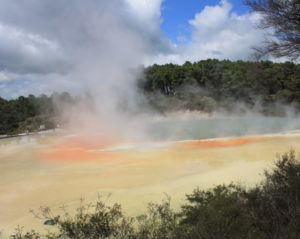 Both types of geothermal heat—though expensive to install—are cheap to run, with multiple units of energy generated per unit spent to run the pumps that bring energy out of the ground.
Both types of geothermal heat—though expensive to install—are cheap to run, with multiple units of energy generated per unit spent to run the pumps that bring energy out of the ground.
Geothermal is also considered a “green” heat source, meaning it’s carbon-neutral.
If run by solar electricity, geothermal could be a viable off-grid heating option.
Ground-loop geothermal heat pumps can even be run backward in the summertime, providing inexpensive cooling without any modifications to the heating system.
Running the system backward has the additional effect of helping to recharge the heat reserves in the ground that power the geothermal system.
Again, the disadvantage of both types of geothermal systems is a very high up-front cost, though payback times can be relatively short—under five years in some cases.
Payback times will be shorter where fuel costs are higher.
In areas where there is geothermal heat close to the surface (like hot springs), deep geothermal will be more affordable, since much of the expense in deep geothermal comes from drilling the very deep shaft needed to access the earth’s heat in most areas.
Though geothermal is presently one of the rarest heat sources for greenhouses, there are an increasing number of greenhouse projects getting their heat from it.
As fossil fuel prices go up over time, and as more geothermal systems are built and prices come down, it will become a more viable source of energy. In some places there may be green energy grants or incentives available for geothermal heating projects.
Recommended Reads
Recent Articles
Want to see your crops thrive this upcoming growing season? The key is in soil fertility and health. Spend time maintaining your soil’s health to guarantee bigger and better crops come harvest time! The following is an excerpt from No-Till Intensive Vegetable Culture by Bryan O’Hara. It has been adapted for the web. What Is Soil Fertility?…
Read MoreMany know the effects of catnip on our feline friends, but few realize that catnip has medicinal effects for humans. From stomach aches to reducing fevers, catnip is a versatile herb with many benefits. The next time you grow this plant for your cat you may end up taking a few cuttings for yourself! The…
Read MoreIt’s time to take control of your seeds and become a plant breeder! Saving your seed allows you to grow and best traditional & regional varieties, and develop more of your own. The following excerpt is from Breed Your Own Vegetable Varieties by Carol Deppe. It has been adapted for the web. Becoming A Plant…
Read MoreTrying to figure out how to manage weeds in your garden beds? Use cover crops and living mulches for weed suppression while your garden flourishes! The following is an excerpt from The Ecological Farm by Helen Atthowe. It has been adapted for the web. Suppressing Weeds With Cover Crops: Getting Started Cover crops suppress weeds…
Read MoreInterested in becoming a mushroom farmer? Shiitake mushrooms are one of the easiest and most profitable places to start. The following is an excerpt from Farming the Woods by Steve Gabriel and Ken Mudge. It has been adapted for the web. (Photographs courtesy of Steve Gabriel and Ken Mudge unless otherwise noted.) The Stunning Shiitake…
Read More

